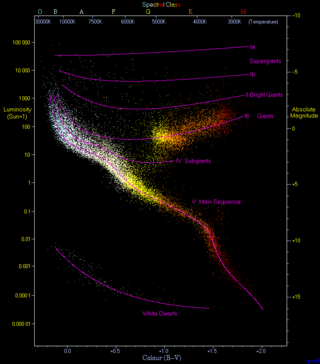
In astronomy, the main sequence is a classification of stars which appear on plots of stellar color versus brightness as a continuous and distinctive band. Stars on this band are known as main-sequence stars or dwarf stars, and positions of stars on and off the band are believed to indicate their physical properties, as well as their progress through several types of star life-cycles. These are the most numerous true stars in the universe and include the Sun. Color-magnitude plots are known as Hertzsprung–Russell diagrams after Ejnar Hertzsprung and Henry Norris Russell.

A nebula is a distinct luminescent part of interstellar medium, which can consist of ionized, neutral, or molecular hydrogen and also cosmic dust. Nebulae are often star-forming regions, such as in the "Pillars of Creation" in the Eagle Nebula. In these regions, the formations of gas, dust, and other materials "clump" together to form denser regions, which attract further matter and eventually become dense enough to form stars. The remaining material is then thought to form planets and other planetary system objects.
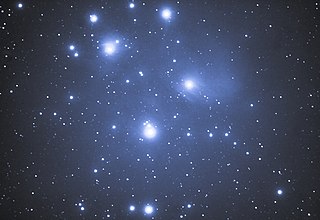
An open cluster is a type of star cluster made of tens to a few thousand stars that were formed from the same giant molecular cloud and have roughly the same age. More than 1,100 open clusters have been discovered within the Milky Way galaxy, and many more are thought to exist. They are loosely bound by mutual gravitational attraction and become disrupted by close encounters with other clusters and clouds of gas as they orbit the Galactic Center. This can result in a loss of cluster members through internal close encounters and a dispersion into the main body of the galaxy. Open clusters generally survive for a few hundred million years, with the most massive ones surviving for a few billion years. In contrast, the more massive globular clusters of stars exert a stronger gravitational attraction on their members, and can survive for longer. Open clusters have been found only in spiral and irregular galaxies, in which active star formation is occurring.

A star is an astronomical object comprising a luminous spheroid of plasma held together by self-gravity. The nearest star to Earth is the Sun. Many other stars are visible to the naked eye at night; their immense distances from Earth make them appear as fixed points of light. The most prominent stars have been categorised into constellations and asterisms, and many of the brightest stars have proper names. Astronomers have assembled star catalogues that identify the known stars and provide standardized stellar designations. The observable universe contains an estimated 1022 to 1024 stars. Only about 4,000 of these stars are visible to the naked eye—all within the Milky Way galaxy.

Stellar evolution is the process by which a star changes over the course of time. Depending on the mass of the star, its lifetime can range from a few million years for the most massive to trillions of years for the least massive, which is considerably longer than the current age of the universe. The table shows the lifetimes of stars as a function of their masses. All stars are formed from collapsing clouds of gas and dust, often called nebulae or molecular clouds. Over the course of millions of years, these protostars settle down into a state of equilibrium, becoming what is known as a main-sequence star.

In astronomy, stellar classification is the classification of stars based on their spectral characteristics. Electromagnetic radiation from the star is analyzed by splitting it with a prism or diffraction grating into a spectrum exhibiting the rainbow of colors interspersed with spectral lines. Each line indicates a particular chemical element or molecule, with the line strength indicating the abundance of that element. The strengths of the different spectral lines vary mainly due to the temperature of the photosphere, although in some cases there are true abundance differences. The spectral class of a star is a short code primarily summarizing the ionization state, giving an objective measure of the photosphere's temperature.
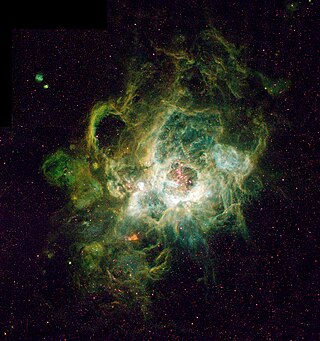
An H II region or HII region is a region of interstellar atomic hydrogen that is ionized. It is typically in a molecular cloud of partially ionized gas in which star formation has recently taken place, with a size ranging from one to hundreds of light years, and density from a few to about a million particles per cubic centimetre. The Orion Nebula, now known to be an H II region, was observed in 1610 by Nicolas-Claude Fabri de Peiresc by telescope, the first such object discovered.

Wolf–Rayet stars, often abbreviated as WR stars, are a rare heterogeneous set of stars with unusual spectra showing prominent broad emission lines of ionised helium and highly ionised nitrogen or carbon. The spectra indicate very high surface enhancement of heavy elements, depletion of hydrogen, and strong stellar winds. The surface temperatures of known Wolf–Rayet stars range from 20,000 K to around 210,000 K, hotter than almost all other kinds of stars. They were previously called W-type stars referring to their spectral classification.

A stellar association is a very loose star cluster, looser than both open clusters and globular clusters. Stellar associations will normally contain from 10 to 100 or more visible stars. An association is primarily identified by commonalities in its member stars' movement vectors, ages, and chemical compositions. These shared features indicate that the members share a common origin; nevertheless, they have become gravitationally unbound, unlike clusters, and the member stars will drift apart over millions of years, scattering throughout their neighborhood within the galaxy.
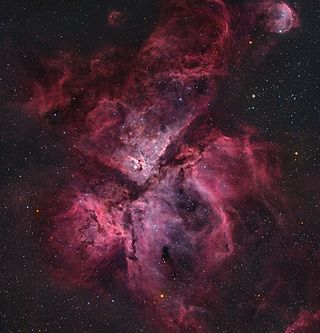
The Carina Nebula or Eta Carinae Nebula is a large, complex area of bright and dark nebulosity in the constellation Carina, located in the Carina–Sagittarius Arm of the Milky Way galaxy. The nebula is approximately 8,500 light-years (2,600 pc) from Earth.

Meissa, designated Lambda Orionis is a star in the constellation of Orion. It is a multiple star approximately 1,300 ly away with a combined apparent magnitude of 3.33. The main components are an O8 giant star and a B-class main sequence star, separated by about 4″. Despite Meissa being more luminous and only slightly further away than Rigel, it appears 3 magnitudes dimmer at visual wavelengths, with much of its radiation emitted in the ultraviolet due to its high temperature.

An A-type main-sequence star or A dwarf star is a main-sequence star of spectral type A and luminosity class V (five). These stars have spectra defined by strong hydrogen Balmer absorption lines. They measure between 1.4 and 2.1 solar masses (M☉) and have surface temperatures between 7,600 and 10,000 K. Bright and nearby examples are Altair (A7), Sirius A (A1), and Vega (A0). A-type stars do not have convective zones and thus are not expected to harbor magnetic dynamos. As a consequence, because they do not have strong stellar winds, they lack a means to generate X-ray emissions.

Tau Tauri, Latinized from τ Tauri, is a quadruple star system in the constellation Taurus. It is visible to the naked eye as a faint point of light with a combined apparent visual magnitude of 4.33. The distance to this system is approximately about 400 light years based on parallax. The system is moving further from the Earth with a heliocentric radial velocity of +14.6 km/s, and it is a member of the Taurion OB association, located between Orion and Taurus. It is located 0.7 degree north of the ecliptic, and thus is subject to lunar occultations.

Xi2 Centauri, Latinized from ξ2 Centauri, is a triple star system in the southern constellation of Centaurus. It is visible to the naked eye with an apparent visual magnitude of 4.30, and forms a wide optical double with the slightly dimmer ξ1 Centauri. Based upon an annual parallax shift of 6.98 mas, Xi2 Centauri lies roughly 470 light years from the Sun. At that distance, the visual magnitude is diminished by an interstellar extinction factor of 0.32 due to intervening dust.

The Scorpius–Centaurus association is the nearest OB association to the Sun. This stellar association is composed of three subgroups and its distance is about 130 parsecs or 420 light-years. Using improved Hipparcos data, Rizzuto and colleagues analysed nearby stars more closely, bringing the number of known members to 436. They doubt the need to add a subclassification because they found a more continuous spread of stars.

HD 36960 is a B-type main-sequence star in the constellation Orion. At an apparent magnitude of +4.78 it is easily visible to the naked eye in many areas, though in most urban areas it cannot be seen due to light pollution. Although it does not have a Bayer or Flamsteed designation, it is brighter than over 30 Flamsteed stars in Orion, as well as being brighter than any of the stars in the nearby Orion Nebula such as θ1 Orionis C and θ2 Orionis.
ι Lupi, Latinised as Iota Lupi, is a solitary star in the southern constellation of Lupus. It is visible to the naked eye with an apparent visual magnitude of 3.54. Based upon an annual parallax shift of 9.65 mas as seen from Earth, it is located around 338 light years from the Sun. At that distance, the visual magnitude of the star is diminished by an extinction factor of 0.23 due to interstellar dust. Relative to its neighbors, this star has a peculiar velocity of 27.4±4.9 km/s. It appears to be a member of the Scorpio-Centaurus OB association.

An O-type star is a hot, blue-white star of spectral type O in the Yerkes classification system employed by astronomers. They have temperatures in excess of 30,000 kelvin (K). Stars of this type have strong absorption lines of ionised helium, strong lines of other ionised elements, and hydrogen and neutral helium lines weaker than spectral type B.
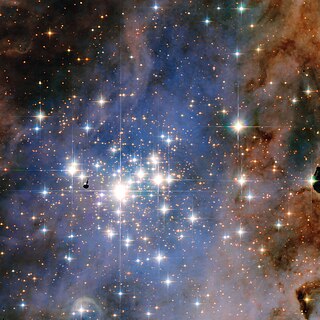
Trumpler 14 is an open cluster with a diameter of six light-years (1.8 pc), located within the inner regions of the Carina Nebula, approximately 8,980 light-years (2,753 pc) from Earth. Together with the nearby Trumpler 16, they are the main clusters of the Carina OB1 stellar association, which is the largest association in the Carina Nebula, although Trumpler 14 is not as massive or as large as Trumpler 16.

Westerhout 40 or W40 is a star-forming region in the Milky Way located in the constellation Serpens. In this region, interstellar gas forming a diffuse nebula surrounds a cluster of several hundred new-born stars. The distance to W40 is 436 ± 9 pc, making it one of the closest sites of formation of high-mass O-type and B-type stars. The ionizing radiation from the massive OB stars has created an H II region, which has an hour-glass morphology.


















